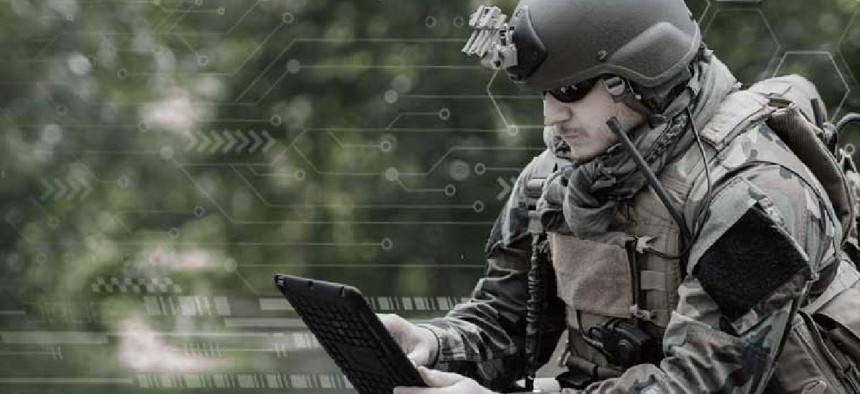Joint operations demand a digital battlefield. Here are key steps for delivering
Cloud-based high-performance computing that is pushed out to the edge gives deployed troops the speed and ubiquitous network connectivity to help them leverage AI tools and enable functionality tailored to the specific mission.
The push toward technology-enabled military dominance and lethality isn’t new -- it is a concept that is nearly as old as war itself. The technology certainly has changed, but the bottom line has not: Secure the decisive advantage and use it to win.
Today that warfighting imperative exists in a complex landscape that’s advancing at a clip far more rapid and more fluid than in previous eras. At least part of this environment is fueled by a commercial world built on technological agility, innovation and, in some cases, near-instant obsolescence.
As the Defense Department and other government agencies look to capitalize on industry’s momentum, the struggle to keep up, to operate at machine-speed and to find a way around bureaucratic log jams and technological disruption all put the U.S. at a tipping point.
“The biggest competitive threat is our own obsolescence,” Lt. Gen. Michael Groen, director of the Joint Artificial Intelligence Center, said recently at a Potomac Officers Club event. “We can’t operate that way. We can’t win that way.”
Groen repeatedly has pointed to the path industry has created for the military to follow: employ scalable artificial intelligence, autonomous systems, modernized business systems and the tools and infrastructure that enable machine-speed data integration and informed decision-making.
These are the catalysts for a joint force that operates cohesively, at a faster tempo than the enemy and with the type of synchronized, real-time common operational picture that’s vital for the U.S. in the cyber domain. This is even more relevant as AI -- and the government’s applications of it -- continue to mature, and as it’s combined with other game-changing elements.
Cybersecurity challenges ranging from data poisoning of AI to zero-day exploits in platforms and applications are the reality of operating in this high-stakes and real-time environment. That places a premium on leveraging maturing commercial ecosystems of comprehensive cybersecurity capabilities -- think extended technology suites or a security fabric that provides constant visibility, anomaly detection and, in some cases, automated fixes.
It’s harder for the adversary to hide when the spotlight is shining and the computer never blinks. Bring that light to the tactical edge and watch true transformation unfold.
Powering speed and data at the foggy edge
High-performance computing (HPC) and processing is making its way to the tactical edge, though as far as some military leaders are concerned, it can’t happen fast enough. With processing available closer to the edge, the pace of collecting, sorting, organizing and creating intelligence from data is dramatically accelerated. In this sense, the cloud -- where data is stored and where the tools operate to manipulate that data and create actionable intelligence -- represents the future of warfighting. But this future also hinges on speed and capability of sensors and systems at the foggy tactical edge.
Cloud-based HPC that is pushed out to the edge -- “fog computing” -- delivers to deployed troops the speed and ubiquitous network connectivity to help them leverage AI tools and enable functionality tailored to the specific mission. Much of that delivery of power to the tactical edge will ride on commercial technology, but once it’s there, operators will blend it with decades of DOD’s unique experience and track record of innovation.
After all, it was the intelligence community and DOD that, in moves a decade ahead of the private sector, expansively deployed sensors in the search for Osama bin Laden. This was the vanguard of instrumenting the battlefield environment -- strategically placing sensors in key terrain to find and identify those communicating with bin Laden and generating the data and analysis eventually leading the U.S. to his location.
This was exquisite technology at the time, and it’s what the power of data in a Joint All-Domain Command and Control context represents: convergence of information from across services, domains, platforms and applications to create decisive intelligence- and speed-driven advantage. The result: capabilities inconceivable just a few years ago, or a digital joint operating construct such as JADC2 that enables data and situational awareness to be real-time and actionable across domains and platforms.
Forward-leaning research and development efforts in industry and within DOD are focused on bringing high-capacity compute and processing to the tactical edge through a number of avenues. This includes software-defined networking, architectures built on cloud-based networking, low Earth orbit satellite communications, 5G, advanced antennas for collection and communication as well as smaller-footprint CPUs, GPUs and DPUs (data processing units) that bring more computing horsepower to a variety of air, ground and sea platforms.
“These initiatives are all, at their core, about getting the entire battle environment digitized, OK? The key is speed of data, having situational awareness, getting data from sensor to shooter as quickly as you can, being as agile as you can. You don’t know who the shooter might be, so you need to have that situational awareness and you need to be agile enough to move data at the speed of relevance,” Acting Air Force Secretary John Roth recently said at an Air Force Association event. “Digitization is the core competency that all of us need for the battlespace of the future.”
To achieve that core competency, industry needs to play its part in providing high-powered, seamless and secure digital functionality at the tactical edge.
NEXT STORY: How NGA is handling hybrid telework




